The Fit Mom’s Guide to Running During Pregnancy
(This post probably contains affiliate links. I receive a small commission at no cost to you through links shared on this website to help keep the information I provide free to you)
Don’t put those running shoes away quite yet!
Whether you were an active runner before pregnancy or just someone who enjoyed jogging occasionally, you might be wondering if it is safe to maintain your running habits or how pregnancy will affect your workouts.
As a Kinesiologist and prenatal exercise specialist, I get asked the question all the time whether it is safe for moms to continue running while pregnant and how to modify their workouts to keep them on their feet.

The good news is that many pregnant women continue their running routines even into the third trimester!
And running is a great way to get in shape and stay healthy during pregnancy, but there are some safety considerations you need to know about before hitting the pavement.
This article will give you all the information you need to run safely while pregnant so that your body and baby remain healthy throughout this special time.
You’ll learn how much running is safe for your body as well as when to stop running altogether during pregnancy.
You’ll also learn what exercises are best for staying strong during pregnancy as well as ways to modify your workouts if they become uncomfortable or unsafe with your changing body size and weight gain.
While I can’t speak on behalf of medical professionals or doctors because every woman is different, these tips should give any mom-to-be that extra boost you need to continue your favorite workout.
Disclosure: Although I am a certified prenatal/postnatal exercise specialist and personal trainer, I am not YOUR trainer. The content on this blog is for informational purposes only and should not be a substitute of the information and advice you receive from a healthcare professional. This website does not replace the medical advice you receive from your provider.
Benefits of Exercise During Pregnancy
First, let’s talk about some benefits of exercising during pregnancy to put some of your fears at ease.
Pregnancy is one of the most magical experiences in life.
But it doesn’t come without its challenges.
Fortunately, staying active can help with all these issues by improving both your physical and mental health as well as the health of your growing baby.
In normal, uncomplicated, and healthy pregnancies, the benefits of prenatal exercise far outweigh the risks.
These benefits include:
- Reduced risk of gestational diabetes, hypertension, and preeclampsia.
- Improve insulin sensitivity which is good for both mom and baby.
- Decrease back pain by strengthening core muscles that support your spine during pregnancy.
- Strengthen abdominal muscles to help with postpartum recovery after.
- Reduce excess pregnancy weight gain that can be unhealthy for both mom and baby.
- Reduce the risk of depression and anxiety due to the release of “feel good” endorphins.
- Reduce overall aches and pains by keeping your body strong.
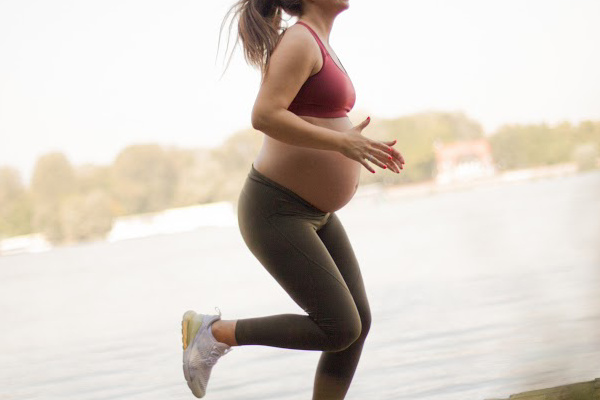
Is It Safe To Run While Pregnant?
The truth about pregnancy running is that it’s different for every expecting mom.
And the safest exercises for pregnant moms may be different for everyone.
Most current research shows that for normal, healthy and uncomplicated pregnancies, prenatal exercise is completely safe and even encouraged.
And the American College Of Obstetricians and Gynecologists recommends pregnant moms to engage in at least 20-30 minutes of moderate-intensity exercise most or all days of the week.
“Women with uncomplicated pregnancies should be encouraged to engage in aerobic and strength-conditioning exercises before, during, and after pregnancy….Activity restriction should not be prescribed routinely as a treatment to reduce preterm birth.
“In the absence of obstetric or medical complications or contraindications, physical activity in pregnancy is safe and desirable, and pregnant women should be encouraged to continue or to initiate safe physical activities.”
With that said, the TYPE of exercise that you chose depends on you and your personal fitness level.
For this reason, always discuss your workout routine with your healthcare provider to make sure they are aware of your workout routines.
Can Running During the First Trimester Cause Miscarriage?
You might receive concern from well-meaning friends and family that exercise during pregnancy, especially those first 12 weeks, can cause complications or worse, miscarriage.
Some even believe that somehow jogging or jumping will cause the baby to “fall out.” (Yes, I have really been asked this!)
However, there is no evidence to support these claims.
Exercise during the first trimester has not been shown to cause miscarriage or premature birth. (source)
The American College of Obstetricians and Gynecologists states that:
“Concerns that regular physical activity during pregnancy may cause miscarriage, poor fetal growth, musculoskeletal injury, or premature delivery have not been substantiated for women with uncomplicated pregnancies.” (source)
Some studies even show that women who stopped their exercise routines during the first trimester had longer labor times and were more likely to require medical intervention during labor such as forceps or Cesarean Sections. (source)
For healthy moms and babies, staying active is safer than NOT STAYING active by reducing your risk of pregnancy complications such as gestational diabetes and preeclampsia; both of which are risk factors for premature birth.
When Should You Stop Running During Pregnancy?
While exercise is considered safe for most expecting moms, if you experience any of the following symptoms during your workouts, stop running and talk to your doctor immediately.
- Bleeding, fluid leaking fluid other than urine such as amniotic fluid or vaginal bleeding
- Regular and painful uterus contractions
- Headache
- Chest pain
- Feeling faint or dizzy
- Calf pain or swelling
- Abnormal muscle weakness that affects your balance
- Shortness of breath before beginning any exercise
If you want to run during pregnancy, the most important thing you can do is learn to listen to your body and always communicate with your healthcare provider.
Can Running During Pregnancy Hurt The Baby?
In normal, healthy and uncomplicated pregnancies, there is no harm in continuing your exercise routine; this includes running.
Your baby is very secure within the womb, so don’t worry about them being bumped around during your workout.
And some babies may even enjoy the soothing movement that exercise provides.
However, if complications arise such as bleeding, preeclampsia, problems with the placenta or if you are having multiple babies, your runs may come with more risk.
Be cautious when running on uneven surfaces to prevent falling or in extreme heat to help prevent dehydration.
Although running won’t harm a fetus, exercise during pregnancy can result in shortness of breath, dizziness or fainting and dehydration.
So be sure to listen to your body and slow down when you may need to do so.
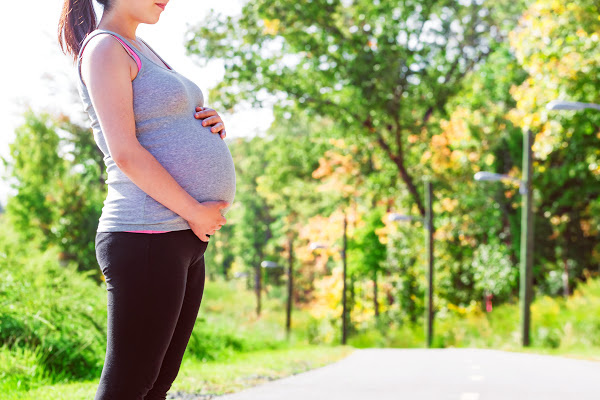
How Pregnancy Will Affect Your Running
Some expecting moms may find running very hard due to exhaustion or nausea while others may run just as they did before getting pregnant.
Whatever the case, pregnancy will affect your running and you will likely need to make adjustments throughout your pregnancy to accommodate these changes.
You should expect some changes such as:
- muscle and joint laxity due to hormonal changes
- weight gain in front of the body
- nausea
- fatigue
- shortness of breath.
Changes in hormone levels, more relaxed joints and ligaments and shifting of your organs to make room for the baby can cause instability and even discomfort in your pelvis.
While you may not feel any issues immediately, running during pregnancy places a lot or pressure on your pelvis, potentially causing issues with back pain, symphysis pubis dysfunction and possibly incontinence; even after the baby is born.
Most runners also find that their pace slows down considerably later in the second trimester and into the third trimester.
At this time a fast walk or another form of exercise may be a better choice as your due date approaches
Can I Start Running During Pregnancy?
Contrary to what you may have been told, current research shows that if you have never exercised prior to pregnancy, incorporating some type of exercise into your routine can offer many benefits to both you and your baby.
However, if you were not a consistent runner before getting pregnant, now is NOT the time to start a running routine.
Running is considered a high-impact form of exercise and for this reason, it is recommended to chose a lower-impact form of aerobic exercises such as walking, aerobics or even an elliptical or stationary bike.
Related: 20 Best Pregnancy Friendly Exercises To Keep You Fit

What is Considered Enough, But Not Too Much?
Your pre-pregnancy mileage is the best way to gauge your running goals during pregnancy.
The routine and pace that is safest for you will depend on your experience prior to becoming pregnant, how far along you are in the process and when your physician recommends that you stop your workouts.
If you were a consistent runner prior to pregnancy, continuing your workouts is typically safe until the third trimester or until you feel that you can no longer run comfortably and with good form.
For some moms, this will be five days a week and for others, it may mean three days.
And while you have probably heard that you should keep your heart rate below certain limits, the most current guidelines recommend using the rate of perceived exertion scale instead.
The ideal intensity should be one where you can carry on a conversation while exercising.
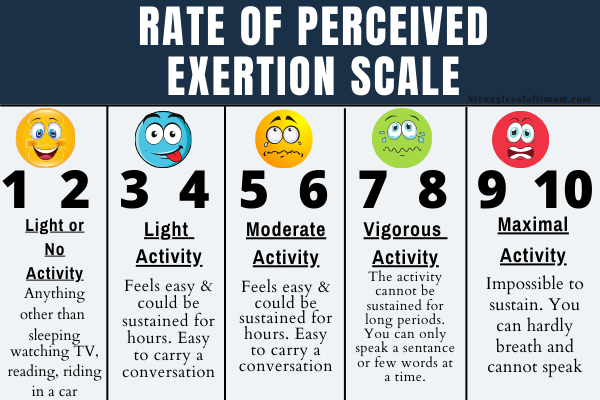
The Top Prenatal Running Modifications
If running is safe for you, there are many options to modify runs during pregnancy in order to keep a healthy balance between exercise and protecting your growing babe.
Keep in mind that as your belly grows, your center of gravity will shift which will make your workouts more challenging, especially in the third trimester.
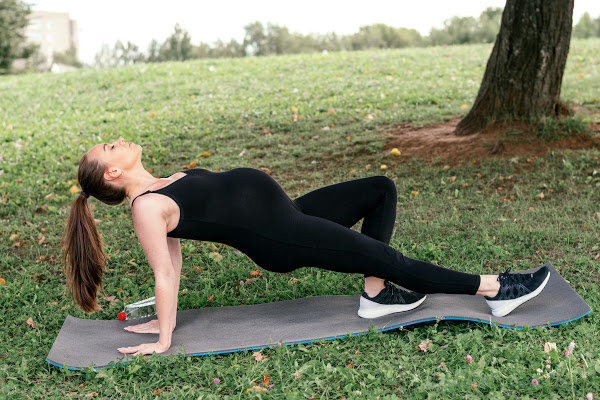
1. Choose quality over quantity
Now is the time to focus on technique over distance to avoid injury.
As your body changes and your pregnancy progresses, focus on maintaining good running form to avoid injury or adding more problems with your core and pelvic floor.
2. Adjust Your Pace
As your belly grows and your stride changes, focus on a running pace that feels comfortable for you and your body.
Now is not a time to set personal records and your workouts should leave you feeling energized, not exhausted.
3. Invest in good running shoes
The combination of loser joints and extra pregnancy weight can be hard on your knees and ankles.
Investing in well-fitted, supportive shoes can help make mileage much safer and more comfortable for your body.
If you are unsure the best shoe for your body, try getting fitted by a specialist at a running store.
4. Buy a supportive sports bra
The added weight gain of your growing breasts can not only make jogging uncomfortable but it can also become painful for both your breasts and your back.
Investing in a solid and supportive sports bra can really save your back and your breasts and make running much more comfortable.
5. Consider using a belly support band or belt
If you experience extra pressure on your pelvis or lower back pain during your prenatal workouts, a belly support belt can help alleviate some of the pressure and discomfort.
Just be careful because the added material could cause you to heat up faster.
6. Compression socks
Every pregnant mom should have at least one pair of compression socks.
Your body is producing is significantly more blood during pregnancy and as your baby grows, your blood vessels dilate to accommodate the extra blood volume.
Compression socks help reduce swelling, relieve pain, and improve circulation which will help your legs feel more comfortable and energized.
7. Use the run/walk method
The run/walk method is an excellent way to maintain your fitness and endurance during pregnancy.
In a typical run/walk workout, you’ll alternate running with walking for a period of intervals.
The ratio can be anything from 30 seconds of running followed by 60 seconds of walking to five minutes of running followed by two minutes of walking.
Incorporating rest intervals helps your body to recover during your run intervals.
8. Stay hydrated
The American College of Obstetricians and Gynecologists recommends at least 8-12 ounces of water per day during pregnancy.
This helps to form the fluid around amniotic fluid that supports the baby and helps in circulating nutrients around the body.
Be sure to drink water or a sports drink before and after your run.
Also, try to avoid caffeinated drinks as they can cause you to come dehydrated more quickly.
9. Avoid running in excessive heat or overheating
Exercising in extreme heat may result in an increased risk for cramps, dehydration and dizziness.
Your body will naturally cool down by sweating but it is still best to avoid running outside when it is very hot.
Make sure you plan your runs accordingly and be listen to your body.
10. Include strength training several days a week
Incorporating strength training will help maintain your muscle mass, improved coordination and most importantly, protect your core, pelvic floor and back muscles.
The Best Strength Training Exercises For Pregnant Runners
Core strength, back pain prevention measures, and pelvic floor exercises are key in ensuring a healthy and injury-free fit pregnancy.
Significant abdominal weakness from your growing bump and an unstable pelvis will have a negative effect on your pelvic floor muscles and back which can cause some residual issues both during and after pregnancy.
Incorporating these exercises can help keep you strong to support your workouts.
Core and Pelvic Floor
Many moms underestimate the importance of core and pelvic floor strength during pregnancy, especially during exercise.
These muscles work together to maintain running posture and prevent common pregnancy-related symptoms such as incontinence, back pain and even pelvic organ prolapse.
Maintaining strength in these areas can help keep jogging pain-free and injury-free.
Related: 5 Prenatal Ab Exercises To Target Love Handles
Related: 6 Prenatal Ab Exercises To Prevent The Pooch
Related: 10 Pubic Symphysis Dysfunction Exercises To Relieve Pelvic Pain

Glutes
Sagging, weak glutes will inevitably put more strain on the hips and pelvis.
Hormones, posture changes, and tight hip flexor muscles are all factors that may cause your running stride to change.
Your running form can significantly improve by maintaining glute strength.
Incorporating exercises such as deadlifts, squats, or lunges to strengthen your entire body can help you run safely during pregnancy.

Back
Runners need strong backs to stabilize the spine and pelvis, both of which take on a lot of extra weight and pressure during pregnancy.
A strong back helps to maintain good posture during pregnancy and keep you up-right to prevent injury.
Try incorporating these workouts into your prenatal workout routine.
Related: 15 Prenatal Ab Exercises For Instant Back Pain Relief
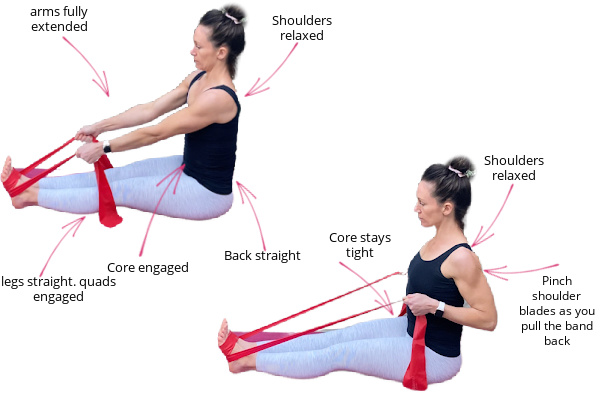
What To Eat Before and After A Run
If your nausea and food aversions allow, eating a small snack of around 150-200 calories that is high in protein and carbohydrates will help fuel your workout and guard against muscle breakdown.
You’ll also want to make sure you are well hydrated before you head out on your run.
Dehydration during pregnancy can cause false labor or Braxton hicks contractions and pregnant mamas need more water than the average person. (source)
If you struggle with getting food down before your run, make sure you are fueling up after your workout.
Eating a balance of protein, carbohydrates and fats will ensure you and your baby are both getting the nutrients required to recover from your workouts.
During my current fifth pregnancy, I am loving Liquid IV Hydration Multiplier before my workouts.
It is low in calories and is full of electrolytes and a little sugar to help fuel my workout.
After my workouts, I look forward to a protein shake with Collagen Protein to support my joints and skin during pregnancy.
Related: 10 Science Backed Benefits of Collagen For Postpartum Recovery

Final Thoughts On Running During Pregnancy
The benefits of staying active during pregnancy FAR outweigh the risk and I encourage you to continue doing the activities you love.
This means that if you were a runner prior to pregnancy, keep going as long as you have permission from your healthcare provider.
However, running throughout pregnancy may not be for everyone but there are plenty of activities and exercises you can do to stay fit during these nine months!
The most important thing is to listen to your body and always be sure that your workout routines are medically reviewed by your health care provider.
I hope these tips helped and I wish you luck on your journey as a new momma-to-be.
And if you enjoyed this running during pregnancy post, please share it with your running friends!
Medically reviewed sources can be found here
FACT CHECK
Struggles of a Fit Mom uses only high-quality sources, including peer-reviewed studies, to support the facts within it’s articles. Read my editorial process to learn more about how I fact-check and keep my content accurate, reliable, and trustworthy.
Physical Activity and Exercise During Pregnancy and the Postpartum Period. (2020). ACOG. https://www.acog.org/clinical/clinical-guidance/committee-opinion/articles/2020/04/physical-activity-and-exercise-during-pregnancy-and-the-postpartum-period
Tinloy, J. (2014). Exercise during pregnancy and risk of late preterm birth, cesarean delivery, and hospitalizations. PubMed. https://pubmed.ncbi.nlm.nih.gov/24439953/
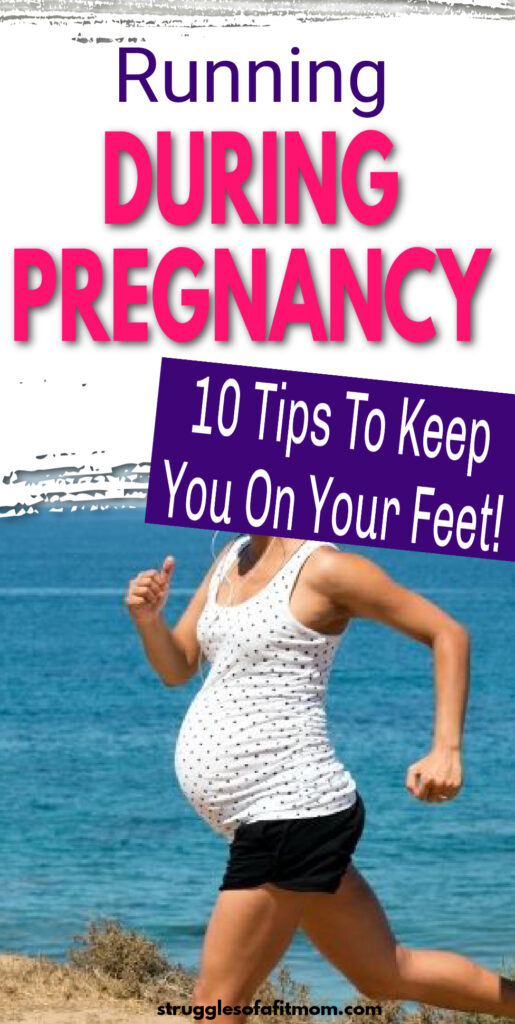

Brooke is a certified Prenatal and Postnatal Exercise Specialist with a Bachelors of Science degree in Kinesiology-Exercise Science. She is also a mom of 3 girls with more than 15 years of experience in health and fitness. Brooke’s goal at Struggles of a Fit Mom is to help motivate, educate and inspire other busy mamas who struggle with finding time, energy and motivation to take care of themselves in the chaos of motherhood.



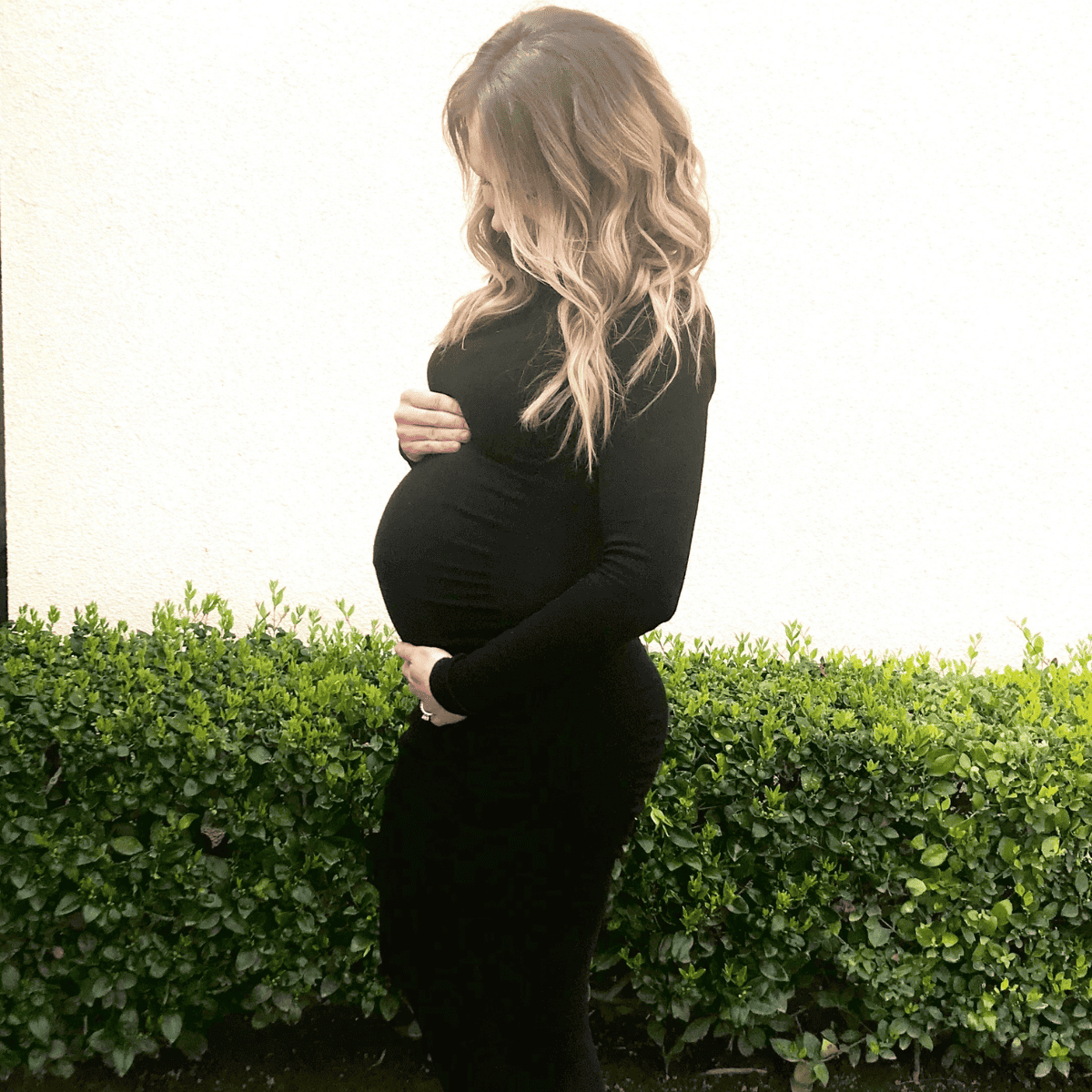


![“I’m Insecure About My Pregnant Body”-[15 Tips To Improve Body Image]](https://www.strugglesofafitmom.com/wp-content/uploads/2021/03/Untitled-design-20.jpg)
